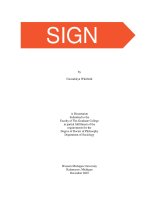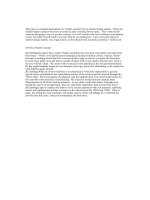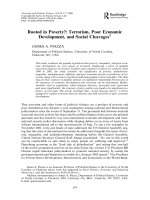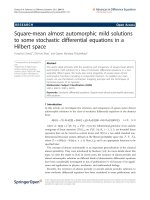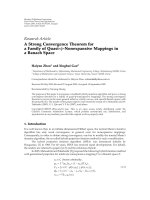Lived experience in a neighbourhood wet market culture and social memories of a disappearing space 1
Bạn đang xem bản rút gọn của tài liệu. Xem và tải ngay bản đầy đủ của tài liệu tại đây (132.28 KB, 10 trang )
LIVED EXPERIENCES IN A NEIGHBOURHOOD WET
MARKET: CULTURE AND SOCIAL MEMORIES OF A
DISAPPEARING SPACE
GALVEZ VICTORIA FRANCESCA
(B.Soc.Sci. (Hons.), NUS)
A THESIS SUBMITTED
FOR THE DEGREE OF MASTER OF SOCIAL SCIENCES
DEPARTMENT OF SOCIOLOGY
NATIONAL UNIVERSITY OF SINGAPORE
2013
ii
Acknowledgements
The race is not to the swift or the battle to the strong,
nor does food come to the wise or wealth to the brilliant
or favour to the learned; but time and chance happen to
them all.
~ Ecclesiastes 9:11-12, The Holy Bible
I dedicate this thesis to the Lord, who is the God of divine appointments and
timings. God had wonderful plans for me at every stage of this work – from inception,
to fieldwork and completion. Having called me to run this (academic) race, He
promised that His presence and favour would go before me. And He has been
absolutely faithful to His Word, patient and reassuring in my moments of weakness,
and encouraging during times of joy. I am proud to say that I have fought the good
fight, finished the race, and kept the faith – 2 Timothy 4:7.
I have been blessed with an incredible family, and I am immensely grateful for
my loved ones. My mother, Florence Teo, has been a competent interpreter during my
fieldwork, and my most fervent cheerleader during the two and a half years that I have
spent on this thesis. For years, I scoured academic feminism for models of strong
women to emulate, never realizing that the quiet, unassuming, sacrificial, and godly
strength of my mother would become the model of femininity that I would deeply
respect and uphold – and still do today. She has given me both roots and wings, and
raised me up to be the woman who I am today. I dedicate this thesis to her. I also
thank my elder brother, Marcello Galvez, for letting me pursue my dream of doing
postgraduate studies; he has been exceedingly understanding of and patient with this
‘book smart’ sister. To my beloved sister, Alexandra Galvez, I sincerely hope that my
endless anthropological adventures (and mishaps) have sparked her passion and
empathy for (social) life and people(s).
I extend my heartfelt appreciation to my marvellous supervisor and teacher,
A/P Maribeth Erb. I could not be more thankful for her. She has walked me through
this entire thesis, remaining ever inspiring, enthusiastic, supportive, and caring. As
one of the anthropologists who ignited my anthropological imagination during my
undergraduate years, A/P Erb has nurtured it and kept it aflame throughout my
postgraduate journey. Her meticulous and finesse assessment of my work has
constantly challenged me to up my game – to rethink and refine my ideas, and to
become a more sensitive and skilful writer, researcher, and thinker. For her kind and
diligent guidance during my undergraduate and postgraduate years, I am deeply
indebted. From the bottom of my heart, thank you, Dr Erb!
When I was an undergraduate, A/P Roxana Waterson also fuelled my
anthropological imagination and curiosity for diverse forms of social life and peoples.
She was an outstanding academic and teacher to me then, and is even more so today.
It was in her Social Memory course that my interest in the (disappearance of the) wet
market was piqued. Her discussion of the 2009 Sheng Siong-Housing Development
Board saga captivated my imagination, and eventually culminated in the birth of this
thesis. I also continued to learn much about anthropology and teaching from A/P
Waterson during my postgraduate journey, and am very fortunate to have her help all
these years. Thank you, Dr Waterson.
iii
A/P Hing Ai Yun has been a blessing to me in more ways than one. She has
been an attentive spiritual and academic mentor, having been there for me during
many trying periods and two theses. She has offered me many pearls of wisdom when
it came to a future career – and life in general – and has showered me with many years
of unconditional love and care. Dr Hing, the Galvezes cannot thank you enough for
being a dear and precious family friend, and for being a godly figure. (And of course,
I assure you that all your branded and beautiful handbags have been put to excellent
use!)
Since my honours year, Dr Kelvin Low has been a remarkable mentor and
friend. He has given me much needed – and appreciated – career and postgraduate
advice, kept me on track with my thesis, and seen me through various phases of life as
I matured from my undergraduate years. Besides being my voice of reason and a
professor whom I greatly respect, I thank him for the many enjoyable, light-hearted
and unforgettable talks, laughs, gatherings, and dinners. For being ever so patient and
objective with Vicky, I thank you for the past few years of friendship (and delectable
treats – chocolates!), Dr Low. (And I am also delighted to report that I can finally
differentiate avocadoes and small bitter gourds in the marketplace!)
Dr Noorman Abdullah is a brilliant and critical academic, and a talented writer
who yields his pen mightily. It has been a great pleasure to work with him and read his
works. He is a seasoned sociologist and teacher whom I look up to, and I have gleaned
numerous insights into medical sociology, Singapore society, and teaching from him.
He is also an excellent listener and friend, and a sharp and witty conversationalist. He
is always ready to lend a listening ear to my (fishmongering) (mis)adventures in
Bedok Market, cat stories, travel experiences, and (unfortunate and recurring) ‘Aunty’
fashion disasters. For all these and so much more, Aunty Vicky extends her utmost
gratitude to you, Dr Noorman.
I am surrounded by terrific friends who have held my hand not only through
my postgraduate stint, but through some of life’s finest as well as darkest hours. I
thank these loved ones for the years of friendship we have shared, and rejoice in the
fact that we have many more years to come. My best friends from secondary school
and junior college: Dr Sarah Yong, Furzanne Faudzi, Stephanie Chan, Wu Zhi Yun,
Gladys Goh, Seah Simin and family, Cheung Ka Yan, Chew Jia Ying, and Chan Yu
Xin. My university friends: Cherie Goh, and Emilyn Yeo. My Sociology and
intellectual playmates: Leong Si Ngah, Lionel Loh, Crystal Abidin, Teresa Tan, Cindy
Liu, Woo Wee Meng, Mohammad Khamsya, Shamil Zainuddin, and Pamela Chia.
The young and bright spark who is mature beyond his years, lights up and stretches
my (academic) imagination, and breathes into me a zest for life: Ng Ding Jie.
Finally, four groups of people have been the heart and soul of this
ethnography, and this thesis would not have been possible without them. Thank you,
Evan and Jacqueline, for your thoughts about the National Heritage Board’s (NHB’s)
Community Heritage Project. My appreciation also goes out to the five heritage
bloggers who have shared their memories of vanishing/vanished marketplaces and
spaces in Singapore, and their ideas of nostalgia and heritage. My engagements with
the bloggers have been intensely revealing, and have made me critically reflect on my
iv
own (taken-for-granted) notions of nostalgia and heritage. I thank my five customerinterviewees for their stories of Bedok Market too.
I am extremely indebted to the hawkers of Bedok Market – especially my key
informants – for their assistance in this study. They did not merely allow me to
conduct research with and about them, but integrated me into their social circles and
the marketplace itself. They patiently taught a novice researcher and wet market
patron about their culture and memories, and blessed me with their care and friendship
(along with many sumptuous foods!). My hawkers have bestowed me with so much
more than I can ever reciprocate; I always left Bedok Market with a full heart (and
stomach). They are the very heartbeat of this work, and I can only pray that this
ethnography remains faithful to their lived and everyday realities. This thesis is about
my hawkers, and for them.
Victoria Galvez
February 2014
v
Table of contents
Page
Declaration page
ii
Acknowledgements
iii
Table of contents
vi
Abstract
ix
Chapter 1. Framing the lived experiences and memories of the marketplace
1.1. Orienting the view: Presenting Bedok Market
1
1.2. Crafting a meaning-centred approach to Bedok Market
1
1.3. Why an ethnography of a neighbourhood marketplace?
5
1.4. On sociality, performance, and social memory
1.4.1. Sociality
15
1.4.2. Performance
18
1.4.3. Social memory
20
1.5. Exploring the culture and social memories of the marketplace 21
Chapter 2. Methodological issues and a saunter through Bedok Market
2.1. Erecting a multi-method framework
23
2.2. Participant observation, tours, and ruminations on the role
of an interpreter
24
2.3. Interviews and popular literature on the marketplace
31
2.4. A history of hawking and wet markets in Singapore
33
2.5. A saunter through Bedok and the marketplace
38
Chapter 3. Exploring socialities in Bedok Market
3.1. Framing Bedok Market as a social space
42
3.2. Customer-customer socialities: Fleeting relationships
43
3.3. Hawker-customer relationships: Transitory relationships
48
vi
3.4. Hawker-hawker socialities
3.4.1. Familial relationships
56
3.4.2. Business networks
59
3.4.3. Anchored personal relationships
63
Chapter 4. Dramatizing transactions in Bedok Market
4.1. Casting the drama of marketplace transactions
69
4.2. Exploring four performance ingredients
4.2.1. Erecting the front stage
70
4.2.2. ‘The ability to talk’
74
4.2.3. Differentiating customers in the marketplace
80
4.2.4. Negotiating price
86
4.2.5. A middle class drama of transactions
89
4.3. A working class theatre of transactions
90
4.4. Back stages of the drama
93
4.5. Dramas of conflict, exclusion, and asymmetry
95
Chapter 5. Narratives of the vanishing marketplace
5.1. Framing the narratives of the disappearing marketplace
101
5.2. Of hardship and resignation: the hawkers’ narrative
103
5.3. Of inconvenience and resignation: the customers’ narrative
109
5.4. Of formal history and ‘social heritage’: NHB’s narrative
113
5.5. Of childhood, nostalgia, and loss of heritage:
the bloggers’ narrative
124
Chapter 6. Coming full circle: Concluding the ethnography
140
Bibliography
146
Appendix 1. Biographies of my informants
155
vii
Appendix 2. Map of Bedok Market
162
Appendix 3. Interview schedule for the hawkers
163
Appendix 4.1. Interview schedule for the customers
167
Appendix 4.2. Interview schedule for Samantha
169
Appendix 5.1. Interview schedule for Peter (blogger)
171
Appendix 5.2. Interview schedule for Brandon (blogger)
173
Appendix 5.3. Interview schedule for Kenneth (blogger)
175
Appendix 5.4. Interview schedule for Daniel (blogger)
177
Appendix 5.5. Interview schedule for Stephanie (blogger)
179
Appendix 6.1. Interview schedule for Evan (NHB staff)
181
Appendix 6.2. Interview schedule for Jacqueline (teacher)
183
Appendix 7. Food glossary
184
Appendix 8. Scenes in Bedok Market
196
viii
Abstract
This thesis is an ethnography of Bedok Market, a neighbourhood wet market
in Singapore, in which I strive to capture some sense of the variegated peoples,
actions, and dynamics that compose the marketplace. In particular, I adopt a meaningcentred perspective to explore two constituents of the micro-level culture of Bedok
Market – the kinds of socialities, and dramaturgical ingredients that comprise what I
call the theatre of buying and selling in this space. Hence, I elicit the complex
everyday realities of two groups in the marketplace – hawkers and customers. I argue
that the ‘social’ is a multiplicity of lived interactions and connections; the qualities of
Bedok Market engineer a range of relationships in this space.
A similar sense of diversity and differentiation surfaces when I consider four
performance components that go into the drama of transactions – the front stage set
up; what hawkers call ‘the ability to talk’; the differentiation of customers; and the
negotiation of price. There are many ways to enact these techniques; a spectrum of
dramaturgical know-how proliferates. When this range is kept to, exchanges are free
of conflict. Nevertheless, degrees of inclusion, exclusion, and asymmetry may
influence transactions, and such interactions teem with tension.
In recent years, a number of wet markets have vanished, and a flurry of
memories has been released vis-à-vis these disappearances. While some stories
recollect the multifarious rhythms of the marketplace, others do not. Therefore, I
complement my ethnography with a narrative angle that builds upon marketplace
culture. Speaking with four categories of people – hawkers, customers, the National
Heritage Board (NHB) staff and their collaborators, and heritage bloggers – I contend
that these groups (dis)engage marketplace culture, and ideas of nostalgia and heritage,
ix
to varying extents. Their tales too, lay out the disparate capacities and vested interests
from which the various groups appropriate the marketplace.
x

